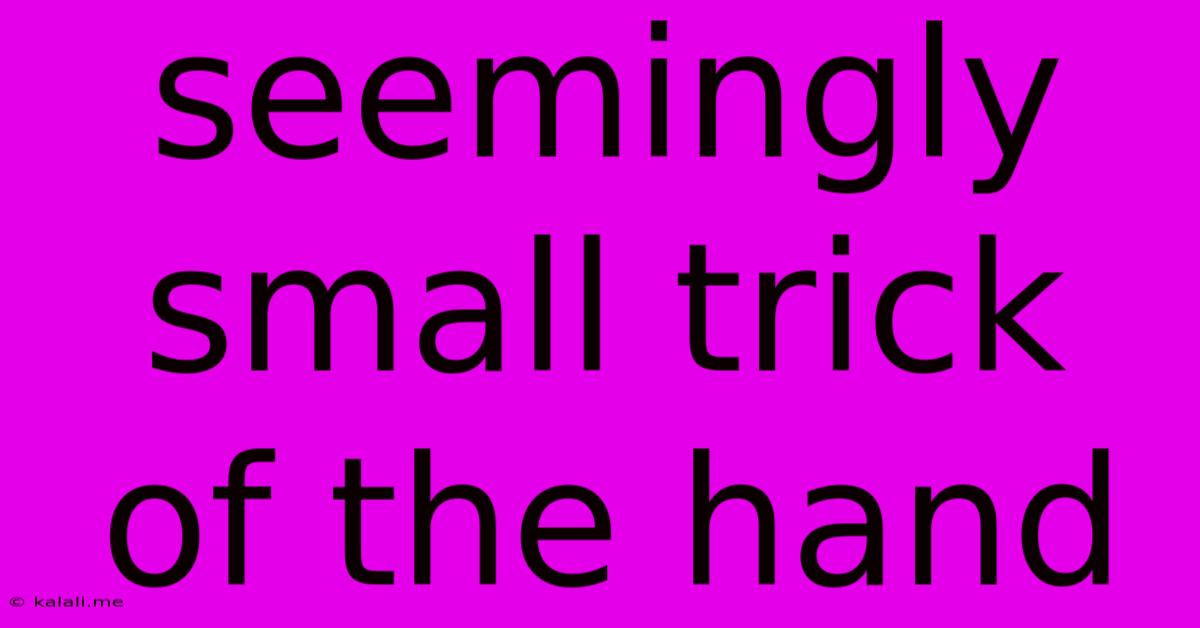Seemingly Small Trick Of The Hand
Kalali
May 21, 2025 · 3 min read

Table of Contents
Seemingly Small Tricks of the Hand: Mastering the Art of Misdirection and Deception
Meta Description: Explore the fascinating world of seemingly small tricks of the hand, uncovering the psychology and techniques behind misdirection and deception in magic and sleight of hand. Learn how seemingly insignificant movements can create illusions that captivate audiences.
Have you ever watched a magician perform a seemingly impossible feat, leaving you wondering how they pulled it off? The answer often lies in the seemingly small tricks of the hand – subtle movements and manipulations that create the illusion of magic. These aren't just about dexterity; they're a masterful blend of technique, psychology, and misdirection. This article delves into the art of these deceptively simple actions, revealing the secrets behind their effectiveness.
Understanding the Psychology of Deception
Before we dive into specific techniques, it's crucial to understand the psychological principles at play. Successful deception hinges on controlling the audience's attention. Magicians use several strategies to achieve this:
- Misdirection: This is the cornerstone of any good illusion. By drawing the audience's gaze to one hand or area, the magician can subtly manipulate something else unseen. This involves creating a focal point, a distraction, or a compelling narrative to divert attention from the actual method.
- Subtlety: The best tricks often involve movements so slight they're almost imperceptible. This requires practice and a keen understanding of human perception. The goal isn't to be flashy, but to be smooth and undetectable.
- Pacing and Rhythm: The timing of movements is crucial. A sudden, jerky movement will immediately raise suspicion, whereas a slow, deliberate motion can mask the true action.
Common Seemingly Small Tricks of the Hand
Several fundamental techniques form the basis of many illusions:
- The Palm: This involves secretly holding an object in the palm of your hand, concealing it from the audience's view. It requires practice to make the object disappear seamlessly. Variations exist, depending on the size and shape of the object.
- The Pass: A pass is the seemingly effortless transfer of an object from one hand to the other, often without the audience noticing. This relies on precise timing and subtle movements, often masked by gestures or words.
- The Turnover: This technique involves quickly turning an object over in the hand, usually to change its orientation or secretly switch it with another. The speed and fluidity of the movement are key to its success.
- The Double Lift: This is a deceptive way to show two cards, when in reality only one card is shown twice. It involves quickly lifting the top two cards as if picking one card.
Beyond the Mechanics: The Importance of Presentation
While mastering the physical techniques is essential, the presentation is equally important. A strong performance involves:
- Storytelling: A compelling narrative can captivate the audience and further distract them from the mechanics of the trick.
- Confidence: Projecting confidence can make even a simple trick appear more impressive. Hesitation or nervousness can betray the illusion.
- Showmanship: Engaging the audience with charm and charisma helps to maintain their attention and create a more immersive experience.
Practicing the Art of Deception
Mastering these seemingly small tricks of the hand requires dedicated practice. Start with simple techniques, focusing on precision and smoothness. Record yourself performing the tricks to identify areas for improvement. Gradually increase the complexity of the tricks as your skills develop. Remember, the goal isn't just to perform the trick, but to create a magical experience for the audience. By understanding the psychology of deception and mastering the subtle movements, you can transform seemingly small actions into captivating illusions.
Latest Posts
Latest Posts
-
How Much Does A Medium Potato Weigh
May 21, 2025
-
Can You Have Sex While Fasting
May 21, 2025
-
How Deep A French Drain Should Be
May 21, 2025
-
Is Vaseline Same As Petroleum Jelly
May 21, 2025
-
How Do You Write Acknowledgements In A Dissertation
May 21, 2025
Related Post
Thank you for visiting our website which covers about Seemingly Small Trick Of The Hand . We hope the information provided has been useful to you. Feel free to contact us if you have any questions or need further assistance. See you next time and don't miss to bookmark.